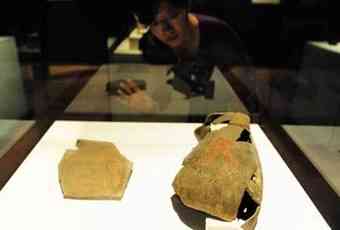The Capital Museum is exhibiting more than 400 precious cultural relics in Beijing on July 29, and nearly 70 percent of those relics are being shown in public for the first time.
 The focus of the exhibition is two red characters written by a Chinese brush pen on a fragment of a flat flask. According to Gao Wei, a researcher from the Institute of Archaeology under the Chinese Academy of Social Sciences and who witnessed the excavation, the unknown red character was a very important specimen, and it indicates that China's history of literature is 800 years older than carapace bone script.
The focus of the exhibition is two red characters written by a Chinese brush pen on a fragment of a flat flask. According to Gao Wei, a researcher from the Institute of Archaeology under the Chinese Academy of Social Sciences and who witnessed the excavation, the unknown red character was a very important specimen, and it indicates that China's history of literature is 800 years older than carapace bone script.
The red brush characters were found at the Taosi ruins site in Shanxi province in 1984. Experts said these mystery characters belong to a mature character system dating back 4,000 years ago, which was even earlier than the carapace bone script, according to Beijing Morning Post's report.
Although archaeologists did not find other characters in the ruins, the few that were found have already shaken up the study of ancient characters.
Gao also said that an archaeologist from Shanxi Province theorized in the 1950s that cultural ruins of the Xia Dynasty might be buried under Taosi region. In order to know more about Xia culture, China's Institute of Archaeology launched the first excavation of this area from 1978 to 1985.
However, when the excavation finished, archaeologists found the characteristics of Taosi culture were clearly different from Xia culture in its early and middle period, and they became similar when the former culture developed to its late period.
That means the flat flask with red brush characters predates the carapace-bone script belonging to the Shang Dynasty by at least 700 to 800 years.
After that, archaeologists found some other red brush characters that belonged to the same period of time as the ones on the flat flask, and that proves China already had a relatively mature character system earlier than carapace bone script.
As of now, one of the two characters on the flat flask is confirmed as the character "wen (文)," while the other one has still not been deciphered and triggered many debates on what it really is.
Zhu Naicheng, director of the Information Center of the Institute of Archaeology under the Chinese Academy of Social Sciences, said that the purpose of publicly displaying the mysterious writing is to attract more people who are interested in ancient writing to join in the discussion and figure out what it is.
Author: Wang Hanlu | Source: People’s Daily Online [July 29, 2010]